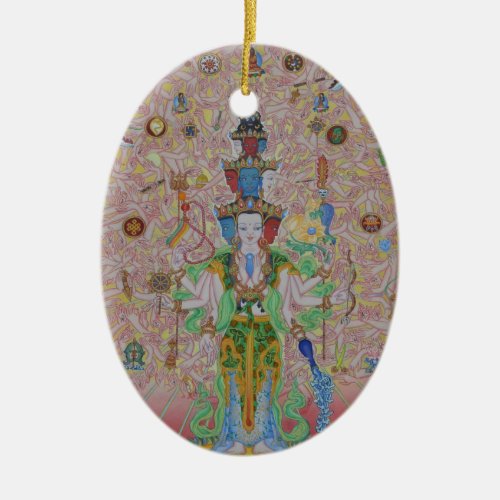Thousand-Armed Avalokiteshvara Ornament



Thousand-Armed Avalokiteshvara Thangka painted by ariya between July 2012 and May 2013 (around 450 hrs) in Bhaktapur/Nepal, Southern India, the French Pyrenees and Berlin. (P.S.: THE ORIGINAL HAND-PAINTED THANGKA IS STILL AVAILABLE! Just contact me if you're interested!) Avalokiteshvara is a bodhisattva who embodies the compassion of all Buddhas. He is one of the more widely revered bodhisattvas in mainstream Mahayana Buddhism. He is also known as Chenrezig (Tibetan), Kuan-Yin / Guanyin (Chinese), Lokeshvara (Sanskrit) and Kannon (Japanese). A total of 33 different manifestations of Avalokiteshvara are described in Buddhist literature, including female manifestations, all to suit the minds of various beings. In Sanskrit, Avalokiteshvara is also referred to as Padmapāni ("Holder of the Lotus") or Lokeśvara ("Lord of the World"). In Tibetan, Avalokiteshvara is known as Jainraisig/Chenrezig and is said to be incarnated in the Dalai Lama, the Karmapa and other high lamas. Seven forms of Avalokiteśvara are known in Tibetan Buddhism: 1. Amoghapāśa: not empty (or unerring) net, or lasso. 2. Vara-sahasrabhuja-locana / Sahasrabhujasahasranetra: 1000-hand and 1000-eye, 3. Hayagriva: with the head of a horse 4. Ekadasamukha: with 11 faces 5. Cundī 6. Cintamani-cakra: wheel of sovereign power 7. Arya Lokiteśvara: the Holy sovereign beholder of the world (loka) Above Avalokiteshvara, wisdom bodhisattva Manjushri (left) and Dharma protector Mahakala (right) are depicted. In the centre, floating on a lotus is Amitabha, Buddha of the lotus family of the 5 Dhyani (wisdom) Buddhas. He is red and represents discriminating awareness-wisdom and its transmuted opposites, passion and grasping. The Padma (lotus) Buddha family is associated with the element of fire. Below Avalokiteshvara, his emanations Green Tara (left) and White Tara (right). Thousand-armed Avalokiteshvara One prominent Buddhist story tells of Avalokiteśvara vowing never to rest until he had freed all sentient beings from samsara, and to postpone his own Buddhahood until he has assisted every being on Earth in achieving Nirvana. Despite strenuous effort, he realizes that still many unhappy beings were yet to be saved. After struggling to comprehend the needs of so many, his head splits into eleven pieces. Amithaba Buddha, seeing his plight, gives him eleven heads with which to hear the cries of the suffering. Upon hearing these cries and comprehending them, Avalokiteśvara attempts to reach out to all those who needed aid, but found that his two arms shattered into pieces. Once more, Amitabha Buddha comes to his aid and invests him with a thousand arms with which to aid the suffering multitudes. Avalokiteshvara with the ending a-svara ("sound, noise"), which means "sound perceiver", literally "he who looks down upon sound" i.e., the cries of sentient beings who need his help, was originally depicted as a male bodhisattva, and therefore wears chest-revealing clothing and may even sport a moustache. In other traditions, he may be depicted more often in female form (Guanyin) or even androgynous. The Lotus Sūtra describes him as a bodhisattva who can assume any form required to relieve suffering, and also has the power to grant children (possibly relating to the fact that in this Sutra, unlike in others, both men and women are believed to have the ability to achieve enlightenment). He is therefore seen as a savior, both spiritually and physically. The sutras state that through his saving grace even those who have no chance of being enlightened can be enlightened, and those deep in negative karma can still find salvation through his compassion. Similarly, in Pure Land Buddhism, Guanyin is described as the "Barque of Salvation". Along with Amitabha Buddha she temporarily liberates beings out of the Wheel of Samsara by placing them in the heart of a lotus and then sending them home to the Western Pure Land of Sukhāvatī, where they will have the chance to accrue the necessary merit so as to be a Buddha in one lifetime. In Tibetan Buddhism, Tara came into existence from a single tear shed by Chenrezig. When the tear fell to the ground it created a lake, and a lotus opening in the lake revealed Tara. In another version of this story, Tara emerges from the heart of Chenrezig. In either version, it is Chenrezig's outpouring of compassion which manifests Tara as a being. Mahāyāna Buddhism relates Avalokiteshvara to the six-syllable mantra: OM MANI PADME HUM. Due to his association with this mantra, in Tibetan Buddhism Avalokiteshvara is also called Shadakshari, which means "Lord of the Six Syllables." Recitation of this mantra along with prayer beads, is the most popular religious practice in Tibetan Buddhism.


